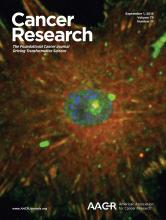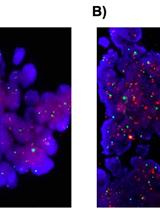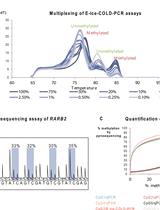- EN - English
- CN - 中文
Single-cell qPCR Assay with Massively Parallel Microfluidic System
大规模平行微流控系统用于单细胞qPCR检测
发布: 2020年03月20日第10卷第6期 DOI: 10.21769/BioProtoc.3563 浏览次数: 5665
评审: Xi FengChaitali BasoleAnonymous reviewer(s)
Abstract
The single-cell transcriptome is the set of messenger RNA molecules expressed in one cell. It is extremely variable and changes according to external, physical and biochemical conditions. Due to sensitivity shortages, most of genetic studies use bulk samples, providing only the average gene expression. Single-cell technologies have provided a powerful approach to a more detailed understanding of the heterogenic populations and minority cells. However, since it is still a quite novel technique, standardized protocol has to be established. Single-cell qPCR, although partly limited by the number of genes, is relatively simple to analyze. Therefore, its use is accessible without the necessity to recourse to complex bioinformatics analyses. The main steps for single-cell qPCR, as illustrated in this protocol, are composed by single-cell isolation, cell lysate, cDNA reverse-transcription synthesis, amplification for cDNA library generation, and finally, quantitative polymerase chain reaction.
Keywords: Single-cell (单细胞)Background
The single-cell transcriptome is the complete set of messenger RNA (mRNA) molecules expressed in one cell. It is extremely variable and changes according to external, physical and biochemical conditions. Hence, it is the source of the biological heterogeneity, in which the cells from the same environment are similar -but not identical- to the other ones.
Due to sensitivity shortages, most of genetic studies use bulk samples, with hundreds to thousands of cells, providing only the average gene expression. This vastly limits the study of minor populations of cells, which may poses specific properties, such as drug resistance or metastatic ability in the case of cancer. Single-cell technologies enable the analysis of the transcriptome at single cell level, unraveling the complexity of heterogenic populations. These technologies have been applied not only in cancer but in many cell biology studies, including adult tissues, stem cells, immune cells; as well as other fields such as microbiology and virology (Wen and Tang, 2016; Karaiskos et al., 2017; Rato et al., 2017; Woyke et al., 2017; Zheng et al., 2017).
There are two main single-cell transcriptome approaches: mRNA sequencing and quantitative polymerase chain reaction. Although mRNA sequencing enables the study of the whole transcriptome without prior knowledge, manipulating an extremely large amount of genes can be overwhelming for novel researchers in the field; moreover high levels of bioinformatics are required (Prieto-vila et al., 2018). To counterbalance, single-cell qPCR analysis is limited to a certain number of genes, but can be analyzed as normal qPCR, being more approachable.
In our previous research, we aimed to study a drug resistant subpopulation of cells by using single-cell qPCR in breast cancer cell lines. With that purpose, we used massively parallel single-cell amplification, that allowed us the study of 96 genes at single cell level to 96 cells per run (Prieto-Vila et al., 2019). This is one of the most commonly used techniques for single-cell qPCR in which reactions are carried in specific 96-well plates, where individual samples are reverse transcribed at the same time. The C1 nanofluidics along with the Fluidigm systems, are the most commonly used systems for sc-qPCR. C1 machine is a hydrodynamic cell trap chip, formed by a net of channels where the cells are eluted and single cells are fiscally separated their size. Thanks to this system, rarely doublets are found. The 96 single cells are then eluded into 96 individual wells. On these wells lysis, reverse transcription, and pre-amplification for qPCR are carried in parallel using a very small reaction volume (Ziegenhain et al., 2017). Following, massive parallel qPCR is done by analyzing the expression of 96 genes in the 96 individual cells in a matrix-manner chip by the Fluidigm system.
In the present protocol, we provide a single-cell transcriptome analysis protocol, including experimental details to perform single-cell qPCR with the Fluidigm systems.
Materials and Reagents
- Pipette tips 1,000 μl/200 μl/20 μl (Sorenson Bioscience, catalog numbers: 34000 / 14220 / 15020 )
- Low binding centrifuge tubes 1.5 ml (Watson BioLab, catalog number: pk-15 c-500 )
- Rainin LTS tips 10 μl (Rainin, catalog number: 30389228 )
- qPCR 96-well plates (Applied Biosystems, catalog number: 4346907 )
- Film for qPCR plates (Applied Biosystems, catalog number: 4311971 )
- Nuclease-Free water (Ambion, catalog number: AM9932 )
For cell culture
- Cell culture 100 mm dishes (Thermo Fisher Scientific, catalog number: 172931 )
- 15 ml conical centrifuge tubes (Thermo Fisher Scientific, catalog number: 339650 )
- Desired cell line, in this case we used the breast cancer cell lines MDA-MB-231 and MCF7
- RPMI 1640x basic medium (Thermo Fisher Scientific, catalog number: C11875500BT )
- Fetal bovine serum (FBS) (Gibco, catalog number: 10270-106 )
Note: FBS should be heat inactivated at 56 °C for 30 min before use. - Antibiotic/antimitotic solution (Thermo Fisher Scientific, catalog number: 15240062 )
- Phosphate buffer Saline (PBS) (DS Pharma Biomedical, catalog number: DSBN200 )
- TrypLE Express (Thermo Fisher Scientific, catalog number: 12604013 )
- Trypan Blue Solution 0.4% (Gibco, catalog number: 15250-061 )
- Neubauer Improved C-Chip (NanoEnTek, catalog number: DHC-N01 )
- 0.5 mol/L EDTA (Nacalai Tesque, catalog number: 06894-14 )
- Initial cell suspension buffer (see Recipes)
For single cell isolation and pre-amplification
- C1 Single-Cell Auto Prep IFC for Preamp (10-17 μm) (Fluidigm, catalog number: 100-5749 )
Note: There are several channel size plates to adjust to the cell size. See notes for more information. - 20x gene specific Assays (Taqman)
- C1 Single-Cell Auto Prep Reagent Kit (Fluidigm, catalog number: 100-5319 )
- Ambion single cell-to-Ct qRT-PCR Kit (Thermo Fisher Scientific, catalog number: 4458237 )
- Live/Dead Kit for mammalian cells (Life Technologies, catalog number: L-3224 ) (see Recipes)
- Lysis mix (see Recipes)
- Reverse transcription final mix (see Recipes)
- 0.2x Pooled Taqman primers (see Recipes)
- Pre-amplification mix (see Recipes)
For single cell qPCR
- Fluidigm 96.96 quantitative PCR Dynamic Array microfluidic chips (Fluidigm, catalog number: BMK-M-96.96GT )
- Taqman Universal PCR Master Mix 2x (Applied Biosystems, catalog number: PN 4304437 )
- 20x GE Sample Loading Reagent (Fluidigm, catalog number: PN 100-7610 )
- 2x Assay Loading Reagent (Fluidigm, catalog number: PN 100-7611 )
- 10x Assays for single-cell qPCR (see Recipes)
- Sample pre-mix (see Recipes)
Equipment
- Neubauer chamber
- Micropipettes (P2, P10, P20, P200, P1000)
- Multichannel pipette P10 with high precision (Rainin, catalog number: 17013802 )
- Cell culture incubator: 37 °C and 5% CO2 (Panasonic Healthcare, catalog number: MCO-170AICUVH-PJ )
- Clean bench (Panasonic, catalog number: MCV-131BNF-PJ )
- Centrifuge for 1.5 ml tubes (Eppendorf, model: 5418R )
- Centrifuge for 15 ml tubes (Tomy, model: Ax-511 )
- Centrifuge for 96-well plate (Sigma, model: 4-16KS )
- Vortex (Scientific Industries, model: Vortex-Genie 2 )
- Fluorescent confocal microscope (Keyence, model: BZ-X700 )
- Refrigerator and Freezer (any company’s product should be fine)
- C1 Auto Prep System (Fluidigm)
- IFC Controler HX (Fluidigm)
- BioMarkHD system for real-time qPCR (Fluidigm)
Software
- Fluidigm Real-Time PCR Analysis Software v.2.1.3
- Fluidigm Data Collection Software v.2.1.3
- Excel
- R (version 3.3.2)
Procedure
文章信息
版权信息
© 2020 The Authors; exclusive licensee Bio-protocol LLC.
如何引用
Prieto-Vila, M., Ochiya, T. and Yamamoto, Y. (2020). Single-cell qPCR Assay with Massively Parallel Microfluidic System. Bio-protocol 10(6): e3563. DOI: 10.21769/BioProtoc.3563.
分类
癌症生物学 > 通用技术 > 遗传学 > 基因表达
生物化学 > RNA > 单分子活性
分子生物学 > RNA > qRT-PCR
您对这篇实验方法有问题吗?
在此处发布您的问题,我们将邀请本文作者来回答。同时,我们会将您的问题发布到Bio-protocol Exchange,以便寻求社区成员的帮助。
Share
Bluesky
X
Copy link













